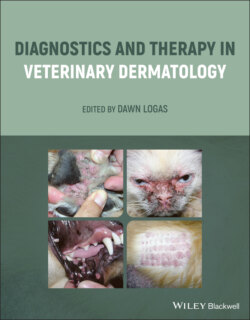Читать книгу Diagnostics and Therapy in Veterinary Dermatology - Группа авторов - Страница 45
The Importance of Diagnostic Investigations in Dermatology
ОглавлениеChanges in the skin and hair coat of animals frequently signal the presence of a primary disease process. These primary conditions create inflammation and changes in the protective skin barrier function. Alteration of the normal mechanisms maintaining cutaneous microbial homeostasis permits bacteria and fungi residing here to flourish. It is important to consider these secondary infections when diagnosing and treating dermatologic conditions, especially because they complicate the diagnosis of the primary disease. Oftentimes, these secondary diseases must be treated prior to further investigation of the primary disease process. Utilization of multiple diagnostic tools in these cases is common because many dermatologic conditions, both primary and secondary, visually appear identical.
Traditional diagnostic procedures continue to provide effective and reliable methods of achieving the correct dermatologic diagnosis. These include otic and skin cytology, fine needle aspiration, skin scraping, trichography (hair plucking), diascopy (a test performed by applying pressure to the skin with a glass slide to observe for blanching), Wood's lamp examination, tissue and hair cultures, and histopathology. These diagnostics have many benefits including affordability, low technical complexity, and easy accessibility. However, results are largely dependent on technical skill, correct lesion selection, and appropriate sample size.
More recently, a transition toward more expensive, rapid, and sensitive testing methodologies using molecular diagnostics has begun. Molecular diagnostic testing uses many different techniques to study the genetic variations in biologic markers found in individual genomes and proteomes. Techniques such as polymerase chain reaction (PCR) or enzyme‐linked immunosorbent assay (ELISA) allow for the detection of microbial DNA from a small sample of skin, even if fungal and bacterial cultures from the same skin were negative.
Molecular diagnostics provide insight into how an individual organism expresses its genetic code, which can dramatically enhance our knowledge of why and how diseases occur. Comparing the genetic code alterations between diseased and normal animals provides a deeper understanding of the pathophysiology of many primary dermatologic diseases. Similarly, assessing changes within an infectious organism's genome before and after antimicrobial exposure improves our understanding of mechanisms of resistance and how selection pressure drives microbial adaptability within the environment. This information can assist us when choosing therapies to target these abnormalities, or when avoiding therapies neutralized by such mutations. Furthermore, new drug development targeting these genetic mutations is paving the way for individualized and safe disease treatments in the future.
Understanding the genomic variations unique to specific diseases will influence the use of animal models of disease and will contribute to the One Health model of disease recognition and treatment. Rapid and sensitive diagnostic methodology can detect emerging diseases within a population, and track prevalence of diseases over time. Molecular diagnostics are very sensitive techniques for achieving a diagnosis when only a small amount of sample is available; however, the techniques are more complicated and more expensive compared to traditional dermatologic diagnostics. Additional limitations to consider include understanding that the presence of DNA does not prove an organism's viability, and measurement of titers does not indicate active infection. This chapter will focus on the updated diagnostic testing modalities available in veterinary dermatology, particularly molecular diagnostics.
